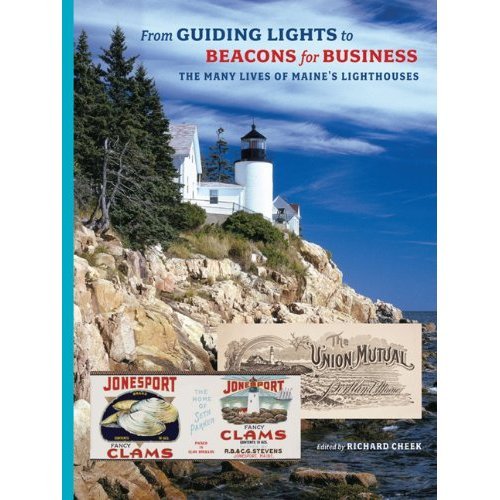How does one begin to describe “From Guiding Lights to Beacons for Business: The Many Lives of Maine’s Lighthouses” with its myriad dazzle and deep content? Perhaps as a happily over-stuffed scrapbook of ephemera enfolding chapter-essays by 10 of the region’s finest, most articulate scholars.
Whatever one decides to call it, “From Guiding Lights” is not your traditional list of Maine’s 63 navigational stations from Kittery to West Quoddy Head. (Of all the states, only Michigan has more).
Julie Sedykh’s jaw-dropping design, with often-overlapping images and caption labels playfully arranged next to or on objects, is nothing like her previous work, “Drawing Toward Home: Designs for Domestic Architecture from Historic New England” (2010). However, it is just as sure-handed and successful.
Cascading images, including painted shells, highway maps, Coast Guard patches, Longfellow poems and first day-issue stamps, fuel the writing. This point is driven home by Historic New England president Carl R. Nold, who talks of using such ephemera to explore the many aspects of lighthouse history and lore beyond the expected.
No boilerplate, this. The seven explorers are among the most knowledgeable historians in the region, and they deliver the unexpected. Photographer and editor Richard Cheek begins with the note: “We (set out to) examine all of the major roles that lighthouses have played in the lives of those who have come in contact with them: authors, artists, photographers, businessmen, religious leaders, tourists, children, and the men and women responsible for keeping the lights on or for preserving the stations for posterity.”
Cheek offers three fine essay sections dealing with children and rescue at sea (Capt. January and real-life hero Abbie Burgess), seamen’s Bethels and the connection of God, and beacons of hope and businesses from the old Union Mutual insurance logo or “Soapine; Enlightening the World.”
Noted maritime researcher W.B. Bunting charts the working history of lights to global positioning systems as “indispensable instruments of safety navigation” with rousing stories of shipwrecks. Assistant director of the Maine Historic Preservation Commission, Kirk F. Mohney, writes two solid chapters — one on the architecture of Down East stations; the other on their continuing maintenance and future.
Timothy Harrison, publisher of Lighthouse Digest, shows us the lives of the people who tended the lenses, and Thomas Andrew Denenberg of Vermont’s Shelburne Museum provides a learned account of the building type in the history of American art, from Charles Codman to Edward Hopper.
Maine state historian Earle G. Shettleworth parallels with a history of photography from an 1858 view of the Venerable Cunner Club at Portland Head Light to the current serene views of Richard Cheek. David Richards of the Margaret Chase Smith Library in Skowhegan enlightens us as to how and why the once utilitarian landmark has become “Maine’s greatest tourist attraction.”
Locals may not always pay attention, but as Maine Sen. Olympia Snowe notes in the introduction, they are symbolic of Maine’s “seafaring history and bedrock characters.” No wonder she introduced a bill in the Senate that would become the Maine Lights Program.
William David Barry is a Maine writer whose books include “Maine: The Wilder Half of New England” and “Deering: A Social and Architectural History.”
Send questions/comments to the editors.


